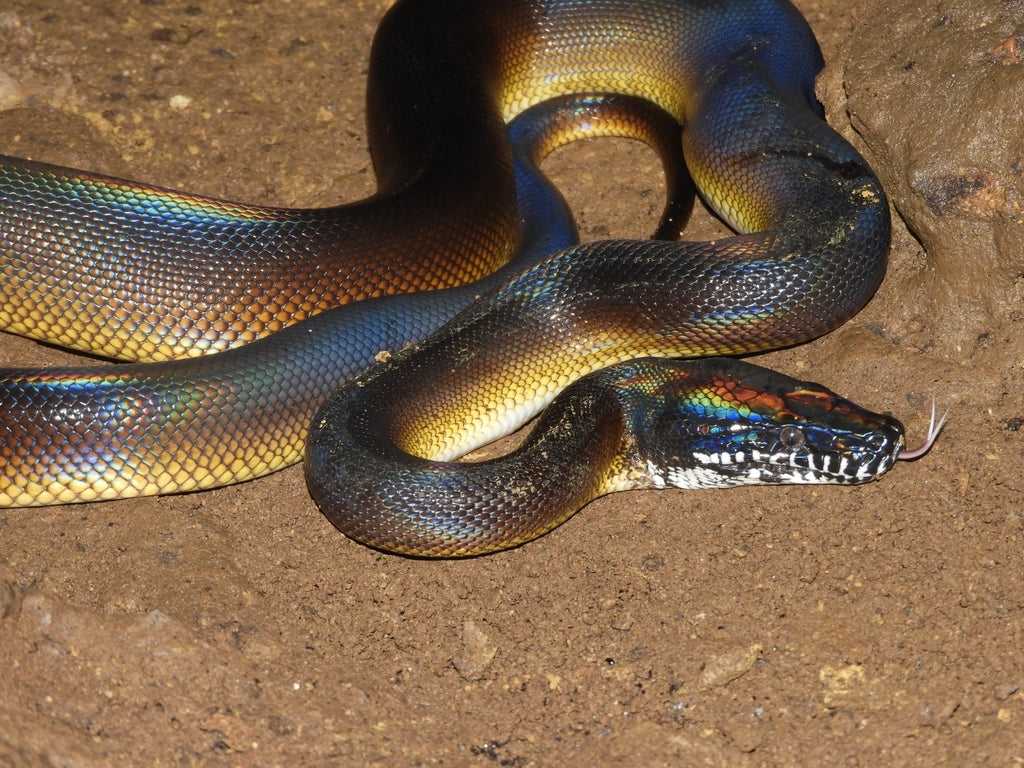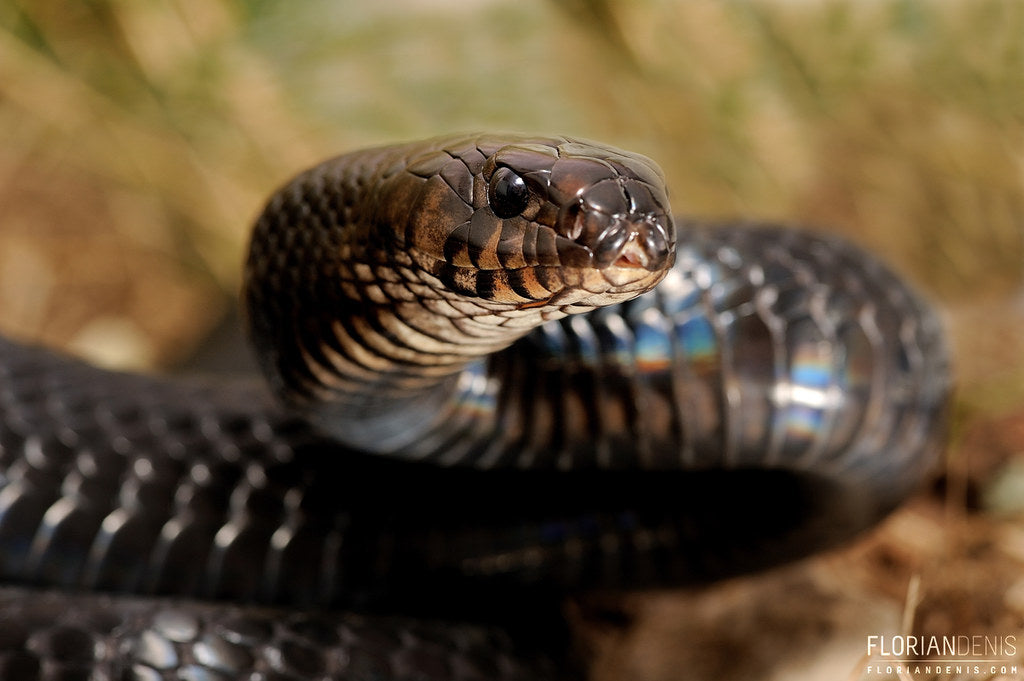Vine snakes (Ahaetulla prasina) are medium-sized, arboreal snakes native to the tropical forests, swamps, agricultural areas, and gardens in south and southeast Asia. As an arboreal species, they spend most of their time in trees.
Vine snakes typically grow to 6-6.5’ long, although their extremely slender build makes them appear smaller. They have a relatively large, elongated head with a pointed snout, smooth scales, and large eyes with horizontal pupils. Coloring is usually bright green, but they can also be yellow or even brownish, and a pale green, yellow, or gray belly.
Vine snakes can be difficult to care for in captivity mostly due to the fact that the majority of them are wild-caught imports. They also require a specialized diet of primarily lizard prey, and tend to have a higher than average parasite load. But with good care, these snakes can live up to 20 years.
How much space do vine snakes need?
Because vine snakes are so slender, it’s easy to think of them as smaller than they really are, keeping them in enclosures that are too small for them to stretch out fully, explore, and climb. Based on their length, the minimum for appropriately keeping one adult vine snake is actually 6’L x 3’W x 6’H. This is just the minimum, so using larger dimensions is beneficial and will happily be used!
Cohabitation (keeping multiple vine snakes in one enclosure) is not recommended, as this is not a social species, and keeping them together causes competition and stress.
Do vine snakes need UVB?
Vine snakes require UVB lighting for optimal health and wellbeing. Providing UVB lighting to your snake gives them all of the vitamin D that their body needs, stimulates better appetite and activity, and strengthens their immune system.
The best UVB bulbs for vine snakes are:
- Zoo Med Reptisun T5 HO 5.0
- Arcadia Forest 6%
The UVB bulb should be housed in a reflective fixture like the Arcadia ProT5 or Vivarium Electronics, and placed close to the heat lamp, about 11-13” above the basking branch if over mesh, and 14-16” above the basking branch if not. UVB is blocked by glass and plastic, so you can’t give your snake UVB by placing its terrarium in front of an open window. Also make sure that the fixture your UVB bulb is in does not have a clear plastic bulb cover. UVB bulbs decay over time, so don’t forget to replace your bulb every 12 months to maintain good performance.
Lights should be on for 13 hours/day during summer and 11 hours/day during winter to simulate natural seasonal cycles.
What basking temperatures do vine snakes need?
Like other reptiles, vine snakes are ectotherms, which means that they need a temperature gradient in their enclosure to help them regulate their metabolism and stay healthy.
Vine snakes need a basking surface temperature between 95-100°F. In the lower levels of the enclosure, the temperature should be between 78-85°F. At night, this temperature can drop down to 72-76°F. Measure the temperatures around your enclosure with an infrared thermometer (temp gun).
Because vine snakes are strictly arboreal, heat mats don’t work for heating them. Instead, provide heat for your snake by imitating the sun with a cluster of 2-4 halogen flood lamps placed on one side of the enclosure, positioned over a sturdy basking branch. Do not use ceramic heat emitters (CHEs), red bulbs, or blue bulbs, as these are not as effective.
However, if you need a source of lightless heat to maintain appropriately high nighttime temperatures, use a radiant heat panel connected to a thermostat.
What humidity levels do vine snakes need?
Vine snakes dehydrate easily, and need an average humidity of 60-100%, as measured by a digital probe hygrometer placed in the middle of the enclosure. Humidity should be lower during the day and higher at night. It’s helpful to install a humid hide for your snake in the upper portions of the terrarium, lined with moistened sphagnum moss. Always having a humid retreat is essential.
Misting your snake’s enclosure with a sprayer first thing in the morning and again at night will help create the right humidity levels. If you need more, installing a cool mist humidifier connected to a humidistat can be helpful for boosting humidity at night in particular.
What substrate is good for vine snakes?
Vine snakes don’t spend any time on the ground, so it’s easy to think that they don’t require substrate at all. However, a good layer of moisture-retentive substrate can be very helpful for maintaining healthy humidity levels. As an added perk, it also tends to make the enclosure more attractive.
Ideally, this substrate should resemble what vine snakes naturally live on in the wild: tropical soil. It should have small particles and hold moisture well. We recommend the following substrates for vine snakes:
- Zoo Med Eco Earth
- Zoo Med ReptiSoil
- Exo Terra Plantation Soil
- Zilla Jungle Mix
Layering clean, chemical-free leaf litter on top of the substrate can also help with humidity.
Substrate should be at least 2” deep and completely replaced every 3-4 months. Remove poop and urates daily, along with contaminated substrate.
What décor can you use in a vine snake terrarium?
It’s terribly boring for a snake to be stuck in an enclosure with nothing in it except substrate, a branch, and a water bowl. It doesn’t matter how big the enclosure is if you don’t put things in it for your pet to use and interact with.
Since vine snakes are arboreal, branches and foliage (live or artificial) are VERY important to include in their enclosure! These branches should be thick enough to support the snake’s weight and placed so they intersect so the snake can have multiple points of contact. (Branches with lots of forks in them are great!)
Additional décor options include vines, cork tubes, and ledges.
Whatever you choose to use, make sure that the snake has plenty of cover to hide in so it can feel secure in its environment.
What do vine snakes eat?
Like other snakes, vine snakes are carnivores, which means that they need to eat whole animal prey in order to get the nutrition that they need. Due to their unusually fast metabolism, it’s best to offer food 2-3x/week. Prey should be roughly the same width as the snake at its widest point.
Unlike most other snakes in the pet trade, vine snakes don’t do well on rodent prey. These snakes are primarily lizard-eaters, so appropriate prey options include:
- house geckos
- green/brown anoles
- feeder frogs
- button quail
- Reptilinks
Occasionally vine snakes may take crickets, small snakes, and pieces of fish fillet.
Although live prey can be used, it’s safest and most humane to use frozen instead. Prey should be thawed in a plastic bag in warm water to approximately 100°F before offering with a pair of soft-tipped tweezers.
Supplements
Snakes can survive without vitamin or mineral supplements, but occasionally using them can help prevent nutritional deficiencies and optimize your pet’s health. Pieces of meat and insects in particular must be dusted with calcium powder before offering. We recommend Repashy Calcium Plus LoD.
Drinking Water
Your snake should have access to clean, fresh water at all times. Since vine snakes are arboreal, it’s best practice to provide a wall-mounted water bowl in a ledge rather than placed on the floor. Keep the water clean and scrub the bowl with a reptile-safe disinfectant weekly.
Do vine snakes like to be handled?
Few reptiles actually “like” to be held, and vine snakes generally prefer to be left alone rather than handled regularly, although some individuals are more tolerant that others. To handle a vine snake, be gentle, and pick up the snake from below rather than from above. Support as much of its body as possible, but don’t try to restrain it; let it explore. More frequent handling is likely to result in a more tame snake, although handling should not take place more than once a day. NEVER pick up a snake by its tail!
Because vine snakes are technically (rear-fanged) venomous, special care should be taken when handling them. If they bite, do not let them chew on you, as that injects more venom, increasing the likelihood of effects such as pain, itching, swelling, and/or numbness. If you are worried about getting bitten, wear thick leather gloves during handling.
*This care sheet contains only very basic information. Although it’s a good introduction, please do further research with high-quality sources to obtain additional information on caring for this species.
"Ahaetulla prasina, Oriental whipsnake - Kaeng Krachan National Park" by Rushen! is licensed under CC BY-SA 2.0




Leave a comment
This site is protected by hCaptcha and the hCaptcha Privacy Policy and Terms of Service apply.